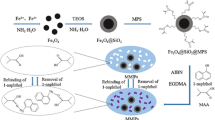Abstract
Molecularly imprinted polymers for detecting plant pollen were designed as artificial recognition materials for quartz crystal microbalances in the gaseous phase. Imprints of birch (diameter, 25 μm) and nettle (diameter, 15 μm) pollen can be generated by polydimethylsiloxane stamping technique as proven by atomic force microscopy. If pollen grains are able to access the cavities and thus are incorporated, the resulting sensors display Sauerbrey-like negative frequency shifts. Non-Sauerbrey behaviour can be observed as soon as pollen is prevented from entering the selective hollows: this results in grain mobility on the electrode surface leading to frequency increases. Access to the cavities is determined by the diameter ratio between pollen grains and imprints as can be revealed during cross-selectivity measurements of nettle and birch pollen imprinted layers. When the amount of pollen grains on the electrode surface exceeds the number of available imprints, the excess particles move freely, resulting in positive, non-Sauerbrey frequency shifts.






Similar content being viewed by others
References
Arnau A (2008) Sensors 8:370–411
O’Sullivan CK, Guilbault GG (1999) Biosens and Bioelectron 14:663–670
Pejcic B, Eadington P, Ross A (2007) Environ Sci and Technol 41:6333–6342
Lieberzeit PA, Dickert FL (2007) Anal and Bioanal Chemistry 387:237–247
Sauerbrey G (1959) Z Phys 155:206–222
Marx KA (2003) Biomacromolecules 4:1099–1120
Davis F, Higson SPJ (2005) Biosens Bioelectron 21:1–20
Lieberzeit PA, Afzal A, Podlipna D, Krassnig S, Blumenstock H, Dickert FL (2007) Sens Actuators B 126:153–158
Ye L, Haupt K (2004) Anal Bioanal Chem 378:1887–1897
Belmont AS, Jaeger S, Knopp D, Niessner R, Gauglitz G, Haupt K (2007) Biosens Bioelectron 12:3267–3272
Alexander C, Vulfson EN (1997) Adv Mater 9:751–755
Wink TH, Van Zuilen SJ, Bult A, Van Bennekom WP (1997) Analyst 122:43R–50R
Lieberzeit PA, Glanznig G, Jenik M, Gazda-Miarecka S, Dickert FL, Leidl A (2005) Sensors 5:509–518
Wiermann R, Gubatz S (1992) Int Rev Cytol 140:35–72
Scott RJ (1994) Molecular and cellular aspects of plant reproduction. Cambridge University Press
Ahlers F, Thom I, Lambert J, Kuckuk R, Wiermann R (1999) Phytochem 50:1095–1098
Jungfernmann C, Ahlers F, Grote M, Gubatz S, Steuernagel S et al (1997) J Plant Physiol 151:513–519
Espelie KE, Loewus FA, Pugmire RJ, Woolfenden WR, Baldi BG, Given PH (1989) Phytochem 28:751–753
Guilford WJ, Schneider DM, Labowitz J, Opella SJ (1988) Plant Physiol 86:134–136
Wilmesmeier S, Steuernagel S, Wiermann R (1993) Z Naturforsch 48c:697–701
Fritsch R, Bohle B, Vollmann U, Wiedermann U, Jahn-Schmid B, Krebitz M, Breiteneder H, Kraft D, Ebner C (1998) J Allergy and Clin Immunol 102:679–686
Dickert FL, Hayden O (2002) Anal Chem 74:1302–130
Hayden O, Mann KJ, Krassnig S, Dickert FL (2006) Angew Chem Int Ed 45:2626–2629
Lieberzeit PA, Schirk C, Glanznig G, Gazda-Miarecka S, Bindeus R, Nannen H, Kauling J, Dickert FL (2004) Superlattices Microstruct 36:133–142
McHale G, Lucklum R, Newton MI, Cowen JA (2000) J Appl Phys 88:7304–7312
Author information
Authors and Affiliations
Corresponding author
Additional information
Dedicated to Prof. Dr. Ernst Kenndler on the occasion of his 65th birthday.
Rights and permissions
About this article
Cite this article
Jenik, M., Seifner, A., Lieberzeit, P. et al. Pollen-imprinted polyurethanes for QCM allergen sensors. Anal Bioanal Chem 394, 523–528 (2009). https://doi.org/10.1007/s00216-009-2718-8
Received:
Revised:
Accepted:
Published:
Issue Date:
DOI: https://doi.org/10.1007/s00216-009-2718-8




